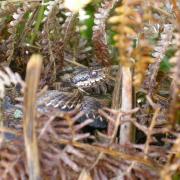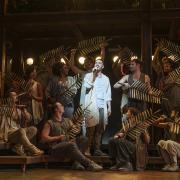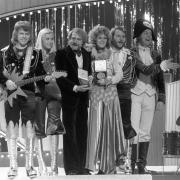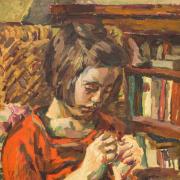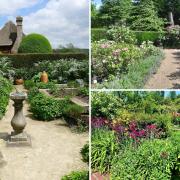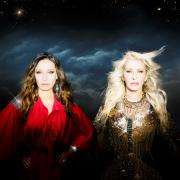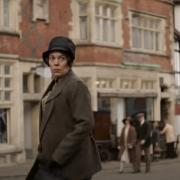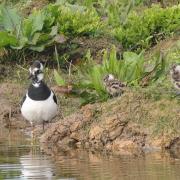Sussex artist Ptolemy Elrington doesn’t mind people describing his work as rubbish. It is. Here, he reveals how he creates amazing animal sculptures from recycled waste

Upcycling may be one of the buzzwords of the moment, but Ptolemy Elrington has turned it into an art form. Literally. From a draughty old flint barn, tucked away on a farm near Portslade in Brighton, he creates sculptures of breathtaking brilliance.
His subjects are often wild animals, birds and mysterious creatures of the deep. An Arctic wolf. A horned owl. A nautilus with rippling tentacles. They are uncannily lifelike, and you feel that at any moment they could sniff the air before taking a tentative step towards you, or launch into flight.
What is all the more remarkable is that these creatures are fashioned from recycled materials. Ptolemy doesn’t work in bronze or clay or stone. He works with hubcaps rescued from the roadside, hulking shopping trolleys dredged from the murky riverbank, secondhand car bumpers left to rust in a salvage yard and unwanted scrap metal retrieved from casually discarded domestic appliances.
To him, the world is a giant Meccano set, ripe for the picking. He’s living proof of that old adage that one man’s trash is another man’s treasure.

Deep in his cavernous workshop, crammed with racks of discarded hubcaps and tools – a sort of Kwik Fit-meets-Mad Max world – Ptolemy, dressed in a bright-red boilersuit, is teasing a fin into life from a sliver of wheeltrim. Beside him, a ferocious viperfish is taking shape, its jaws outstretched to reveal rows of razor-sharp teeth. Look a little closer and you’ll see its unblinking eye is actually a Skoda badge.
Ptolemy, or Uncle Bulgaria as he calls himself, in a nod to his Womble-like salvaging instincts, has a gift for spotting the potential in seemingly lifeless metal and plastic. The legs of a mustang horse, which has been three months in the making and is about to be shipped to Canada, are actually old computer stands. They also came in handy when he was making a post-apocalyptic cyber spider (as you do).
“I found a bucketful dumped at the back of a shop in Brighton, and carried them home,” he says. “I’m planning to make a wasp, and maybe a scorpion, along similar lines.”
Despite the growth in cheap alloy wheels, he never runs out of hubcaps. “I receive a lot of donations and I still find them occasionally on the side of the road. I also visit scrapyards, if I need something specific. When I was commissioned to make a peacock and needed to find materials in a specific shade of blue, I located a dealer who specialised in broken and secondhand car bumpers. I rarely spray my work because I like the natural look. Scratches and abrasions add to the character and history.”

Ptolemy, who studied art and design in the mid 1980s, was inspired to work with found objects when he took a trip to India. “I saw adults and children in bare feet clambering over this enormous rubbish tip, collecting tiny pieces of wire to sell on,” he says. “That got me thinking about how wasteful we are in the West, and the possibilities of recycling. Coming back to Brighton, and seeing all the waste left lying around, made me so annoyed. It still does.”
Another epiphany came shortly after he had completed his art training in Bradford. He lived near a sharp bend in the road where cars often lost their hubcaps, and he started collecting them. “Initially, I thought I could make them into a suit of armour. Then, one day, I spotted a shark’s mouth in one. I realised I could cut around the shape, so I started cutting the hubcaps up, adding pieces and then taking them away, and it grew from there.”
Hubcaps, he says, come in two basic types – bendy and brittle. His favourites are the pliable ones, usually from luxury car brands like BMW and Mercedes, because they can be manipulated and twisted into the shapes he wants.
No project seems to daunt Ptolemy, and his largest pieces have included a giant bee made from recycled Ecover bottles and a 25ft-long articulated dragon, with a drum kit attached, for a Brighton-based Trinidadian band, which roared and puffed out smoke. But despite this, scale is actually quite critical. Too big, and hubcaps end up looking like, well... a pile of hubcaps. Too small, and you can’t see the detail.

One of Ptolemy’s greatest skills is unerringly capturing the shape and essence of an animal with such seemingly clumsy and unyielding materials. When you look at his Arctic wolf, you can almost hear its baleful cry and you are instantly transported to a frozen mountaintop, beneath a hunter’s moon. The arch of its neck, the weight of its paws on the ground, even its musculature, are all captured by artfully cutting and wiring together a handful of well-chosen hubcaps. Training, experience and, above all, close observation are the key, he says.
Mind you, he’s also a perfectionist. He made the head of the Arctic wolf no fewer than four times. He used to have a shark hanging over the door of his studio and had that down, with the tail off, countless times. “I’m a real stickler for detail,” he says. “I try to work as closely as possible to photographs or, where possible, the creatures themselves.”
Ptolemy has been making his hubcap creatures since the 1990s and has attracted the eye of large corporate clients and environmental bodies such as Kenwood, Ronseal, the Eden Project, the Environment Agency and the RSPB. He also accepts commissions from private individuals and works on his own pet projects, which can be purchased through his website.
The BBC even came a-calling when they asked him to make a lifesize replica of the Blue Peter dog, Mabel, for her birthday, and brought the original down to Brighton so he could measure her vital statistics.
But Ptolemy also declines lucrative contracts if he feels a potential client conflicts with his values because his work is underpinned by a passionate concern for the environment.
“I won’t reveal names, but one company was really surprised when I turned them down,” he says. “They stressed that there was a lot of money involved, but I said it wasn’t about the money – it was how I felt about the work.”
In the face of the growing threat posed by climate change and our ever-expanding landfill problem, Ptolemy believes that we, as consumers, as well as designers and manufacturers, need to radically rethink our modus operandi.
“Our attitude to the thrill of acquisition needs to change and we need to think of new ways of looking at a second or even third life for a product,” he says. “That way, the recycle can just become the cycle.”
He’s nevertheless encouraged that the environmental dialogue has stepped up a massive notch in the past year or two, and manufacturers are gradually waking up to the fact that we have finite resources.
“I feel positive that we will meet these changes because human beings are clever and adaptable,” he says. “I just wish it could happen more quickly.”




